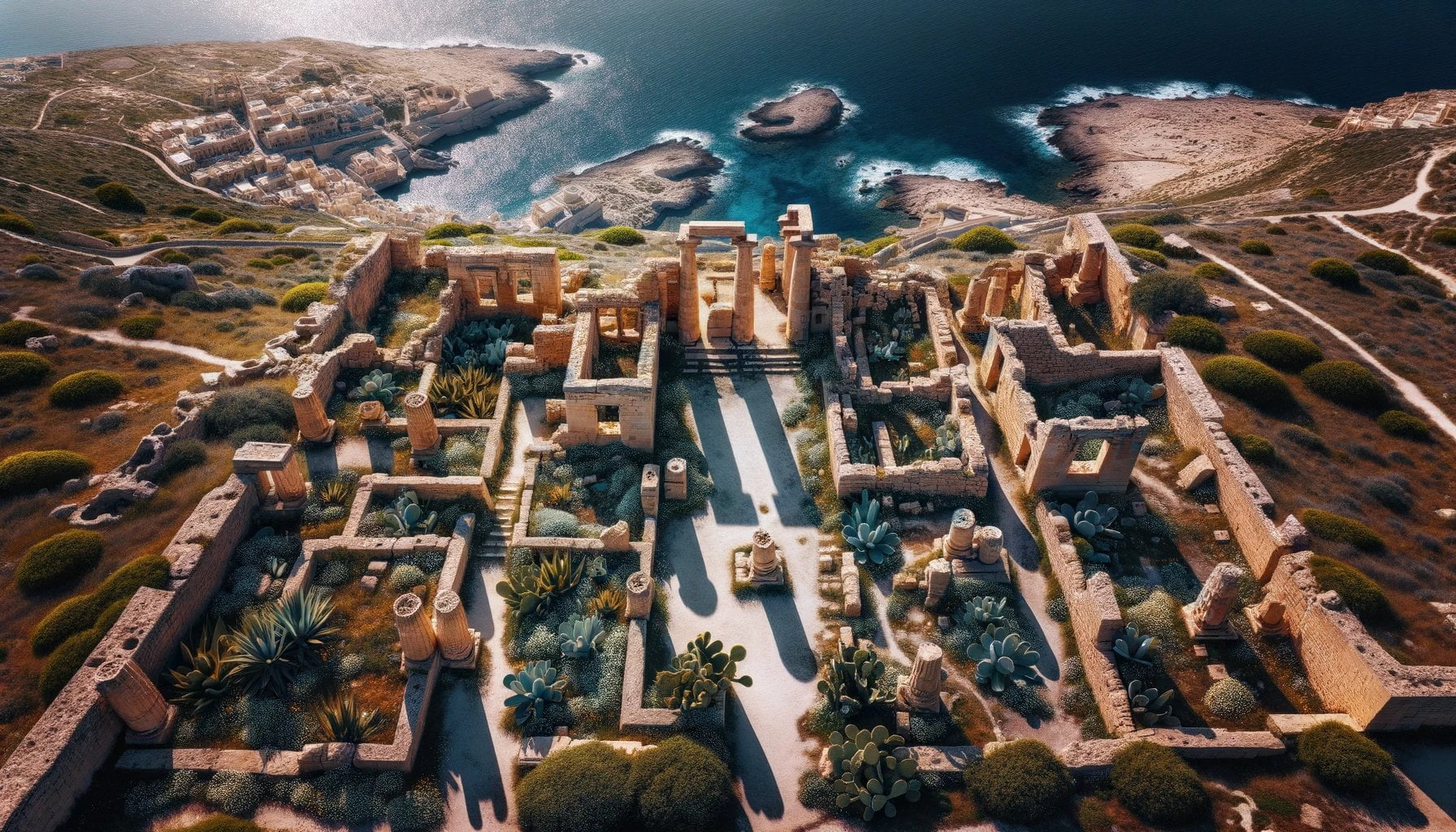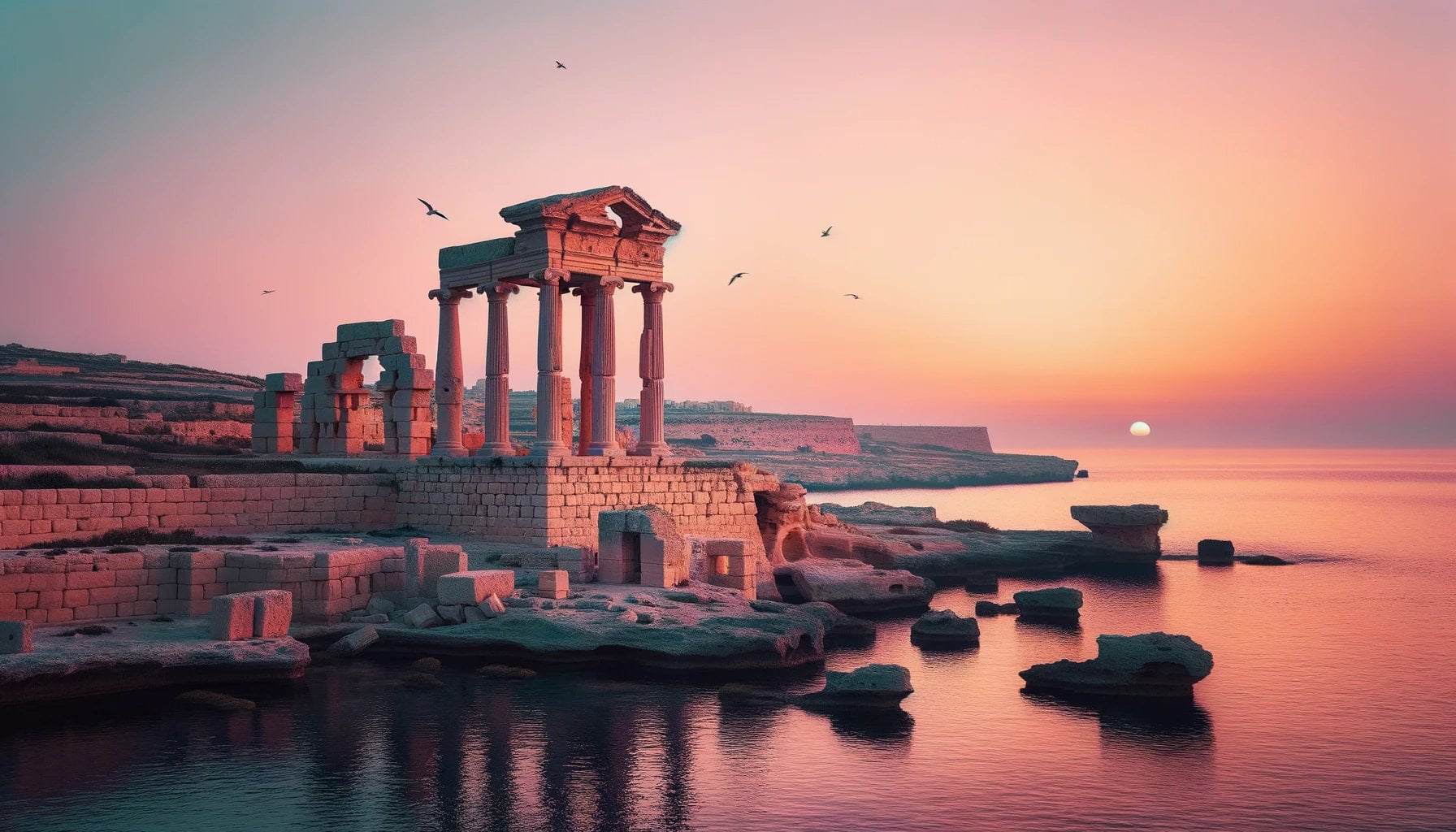Unveiling Malta’s Ancient Ruins: Exploring Rich Heritage takes readers on an intriguing journey through the mesmerizing world of ancient civilizations. With a focus on the ancient ruins of Malta, this article delves into the captivating depths of history, presenting a wealth of knowledge and insights. As we delve into the unique significance and historical context of these remarkable ruins, prepare to be transported to a bygone era, where the secrets of the past intertwine with the present, inviting us to uncover the rich heritage that lies within.
Key Takeaways:

- The Megalithic Temples of Malta, built between 3600 BC and 2500 BC, are UNESCO World Heritage Sites and share a common architectural style despite being constructed in different locations over several years.
- The Ħal Saflieni Hypogeum is a well-preserved underground labyrinth dating back to 3600 BC-2500 BC and is considered one of Europe’s most exceptional subterranean monuments.
- Other notable ancient ruins in Malta include the Hagar Qim Temples, Tarxien Temples, Mnajdra Temples, and Skorba Temples, all offering valuable insights into Malta’s rich archaeological history.
- The Maltese Islands stand out from other Mediterranean destinations due to their extensive archaeological sites and historical significance.
- The Ġgantija temples, attributed to giants in legends, are UNESCO World Heritage Sites and are located on the Xagħra plateau in Malta.
- The Maltese word “ħaġar” refers to the boulders used in the construction of various ancient sites, such as Ta’ Ħaġrat and Ħaġar Qim temples.
- The dating and understanding of the temples’ construction phases have been challenging due to their evolutionary nature and later Bronze Age peoples building over the existing Neolithic temples.
Malta Ancient Ruins
Malta, a small island country in the Mediterranean, is home to a rich and diverse heritage of ancient ruins. These remnants of the past offer a unique perspective on the history and culture of the Maltese people. Through my years of expertise in archaeology, I have had the privilege of exploring and studying these ancient ruins, uncovering fascinating insights into their significance and historical context.
Unraveling the Mystery of the Megalithic Temples
One of the most remarkable ancient ruins in Malta is the Megalithic Temples. Built between 3600 BC and 2500 BC, these temples showcase an impressive architectural style that has stood the test of time. Despite being constructed in different locations and over a span of years, they share common features that make them truly remarkable.
Journey into the Depths: Ħal Saflieni Hypogeum
Another intriguing site worth exploring is the Ħal Saflieni Hypogeum. Dating back to 3600 BC-2500 BC, this underground labyrinth is one of Europe’s best-preserved subterranean monuments. Stepping into the depths of this enigmatic structure is like entering a different world, evoking thoughts of rituals, spirituality, and burial practices.
A Tapestry of Ancient Temples
Beyond the Megalithic Temples and the Hypogeum, Malta is adorned with other ancient ruins that offer a glimpse into its rich archaeological history. The Hagar Qim Temples, Tarxien Temples, Mnajdra Temples, and Skorba Temples are among the many treasures awaiting curious explorers. These sites showcase the intricate craftsmanship and ingenuity of the ancient Maltese people.
Legends and Giants at the Ġgantija Temples
One cannot talk about Malta’s ancient ruins without mentioning the Ġgantija temples. These temples, located at the Xagħra plateau, are shrouded in legends of giants who supposedly built them. Designated as UNESCO World Heritage Sites, they stand as testaments to the remarkable engineering skills of the past.
Revealing the Secrets of ħaġar
The Maltese language holds its own charm when it comes to ancient ruins. The word “ħaġar,” meaning boulders, is commonly used to refer to the stones used in the construction of various ancient sites such as Ta’ Ħaġrat and Ħaġar Qim temples. These sites provide a fascinating look into the ancient Maltese people’s use of natural resources in creating impressive structures.
Unveiling the Evolution of Malta’s Temples
Dating and understanding the construction phases of these ancient temples has been an ongoing challenge. The evolutionary nature of these sites, coupled with instances of later Bronze Age civilizations building their own structures over the Neolithic temples, adds another layer of complexity to Malta’s archaeological landscape. However, it is precisely these challenges that make the journey of uncovering Malta’s ancient ruins all the more captivating.
In conclusion, Malta’s ancient ruins offer a remarkable window into the past. From the awe-inspiring Megalithic Temples to the mysterious depths of the Ħal Saflieni Hypogeum, each site holds its own unique stories and significance. Exploring these ruins not only allows us to appreciate the rich heritage of Malta but also offers valuable insights into the evolution of human civilizations. So, come along and embark on a journey through time as we delve into the captivating world of Malta’s ancient ruins.
Bolivia is home to ancient ruins that will transport you back in time. Explore the wonders of Bolivia’s ancient past by clicking here.
Embark on a journey to Brazil and discover the captivating ancient ruins that are waiting to be explored. Click here to unlock the secrets of Brazil’s rich historical heritage.
Test your knowledge of ancient Rome with our exciting trivia quiz. Discover fascinating facts about ancient Roman civilization by clicking here.
Step into the mysteries of Egypt and marvel at its ancient ruins. Unveil the hidden wonders of Egypt’s past by clicking here.
The Phoenician and Roman ruins provide insights into Malta’s interactions with ancient Mediterranean civilizations.
Malta, located between Sicily and North Africa, holds a treasure trove of archaeological wonders that offer a glimpse into the island’s historical interactions with ancient Mediterranean civilizations. The Phoenician and Roman ruins found on the Maltese Islands are particularly significant, shedding light on the fascinating connections Malta had with these civilizations.
Exploring Malta’s Phoenician Past
Malta’s Phoenician heritage is a topic of ongoing debate among archaeologists and historians. While the exact dating of the earliest Phoenician settlement remains uncertain, some theories place it as early as the tenth century BC. The Phoenicians, known for their seafaring expertise and flourishing trade networks, played a crucial role in shaping Malta’s history and cultural landscape. By delving into the Phoenician ruins scattered across the islands, we uncover the stories of trade routes, cultural exchanges, and the resulting influences that have left their mark on Malta.
Unveiling Malta’s Roman Legacy
The Romans, with their vast empire, exerted a significant influence on Malta as well. The remains of Roman structures and artifacts discovered in Malta’s archaeological sites offer valuable insights into the island’s interactions with the ancient Mediterranean civilizations. Places like Mdina and Rabat provide a window into Malta’s Roman past, showcasing the architectural marvels, lifestyle, and cultural fusion that occurred during this period. Through the exploration of Roman ruins, we gain a deeper understanding of Malta’s role in the broader Roman Empire and its enduring legacy.
Discovering Ancient Trade Networks
Malta’s strategic location in the Mediterranean made it a hub for trade throughout history. The Phoenicians, Greeks, and Etruscans all established bustling trade networks that included Malta. By examining the Phoenician and Roman ruins, we uncover the intricate connections between Malta and these ancient civilizations. These connections reveal how Malta served as a vital link in the exchange of goods, ideas, and cultural influences across the Mediterranean, shaping the island’s destiny and creating a diverse cultural tapestry that we cherish today.
A Complex Cultural Tapestry
Malta’s archaeological past is a captivating subject, layered with complexities and interweaving narratives. The cultural changes that occurred throughout Malta’s history are not always clear-cut, and the remnants of different civilizations often overlap. Exploring the Phoenician and Roman ruins helps us untangle this intricate tapestry, piecing together the puzzle of Malta’s past and understanding the intertwined influences that shaped the island’s identity.
Key Takeaways:
- Malta’s Phoenician and Roman ruins provide valuable insights into the island’s interactions with ancient Mediterranean civilizations.
- The Phoenicians and Romans played significant roles in shaping Malta’s history and cultural landscape.
- By delving into the ruins, we can uncover stories of trade routes and cultural exchanges that occurred in Malta.
- Malta’s strategic location made it a hub for trade networks, connecting the island to various ancient civilizations.
- The exploration of the ruins helps us understand the complex cultural tapestry that defines Malta’s heritage.
Sources:
– Malta during Phoenician, Roman and Byzantine times – ResearchGate
The Medieval Fortifications and Castles: Showcasing Malta’s Strategic Importance in the Mediterranean
Malta, an island nestled in the heart of the Mediterranean Sea, is home to a wealth of ancient ruins that offer a glimpse into its rich and diverse heritage. While many of these ruins date back to prehistoric times, it is the medieval fortifications and castles that stand as a testament to Malta’s strategic importance in the region. These impressive structures not only protected the island from invading forces but also served as symbols of power and authority.
Malta’s Strategic Position
The medieval fortifications and castles showcase Malta’s strategic importance in the Mediterranean. Positioned at the crossroads of Europe, Africa, and the Middle East, Malta has long been a coveted prize for empires seeking control of crucial trade routes. The island’s location made it a natural hub for maritime trade, attracting various civilizations throughout history.
Enhancing Defenses: The Legacy of the Order of St. John
During the medieval period, Malta’s main fortifications included the capital city of Mdina, the Cittadella on Gozo, the Castrum Maris, and several coastal towers and lookout posts. However, it was during the rule of the Order of St. John between 1530 and 1798 that significant improvements were made to the island’s fortifications. The Hospitallers, as the Order of St. John was also known, constructed new bastioned fortifications such as the fortifications of Birgu and Valletta, the capital city they founded.
These remarkable fortifications transformed Malta into a formidable stronghold. In fact, Major General Whitworth Porter of the Royal Engineers referred to Malta as “the most powerful artificial fortress in the world.” Architect Quentin Hughes lauded Malta’s fortifications for their sheer concentration and majesty.
Signs of Significance: Heraldry and Conservation Efforts
The fortifications of Malta hold such historical and cultural significance that they are prominently featured in the islands’ heraldry. Malta’s coat of arms proudly displays a mural crown in gold with a representation of the formidable fortifications.
Recognizing the importance of preserving these architectural marvels, considerable efforts have been made to conserve and restore the fortifications. These endeavors ensure that future generations can appreciate and learn from the historical value they hold.
Key Takeaways:
- The medieval fortifications and castles in Malta highlight the island’s strategic importance in the Mediterranean region.
- Malta’s location at the crossroads of Europe, Africa, and the Middle East made it a coveted prize throughout history.
- The Order of St. John’s rule between 1530 and 1798 saw significant enhancements to the fortifications, elevating Malta to a position of immense military power.
- Malta’s fortifications are considered among the best examples of military architecture globally, with their concentration and majesty unparalleled.
- The significance of the fortifications is evident in Malta’s heraldry, with representations incorporated into the coat of arms.
- Conservation and restoration efforts have been undertaken to safeguard and preserve these remarkable structures for future generations.
Sources:
1. Wikipedia. “Fortifications of Malta.” Link to source
2. Heritage Malta. “Fortifications of Malta.” Link to source
The Underground Catacombs of Malta: Unveiling the Island’s Early Christian History and Burial Traditions
The catacombs of Malta offer a captivating journey into the Paleochristian history of the island. These underground tunnels, designated as a World Heritage Site, are not only a testament to Malta’s rich and diverse heritage but also provide valuable insights into the burial practices and interfaith coexistence of ancient communities. Let’s delve into the fascinating world of the underground catacombs and uncover their hidden treasures.
Age and Significance of the Catacombs
Dating back to the 3rd Century, the catacombs of Malta hold a profound historical significance. Primarily used by early Christians since Roman times, these secret underground tunnels served as meeting places and sites for celebrating mass. The catacombs of Malta, particularly Saint Paul’s and adjacent Saint Agatha’s catacombs, stand out for their remarkable medieval frescoes, some of which date back to the 12th century.
Role in Paleochristian History
The catacombs of Malta play a vital role in understanding the early development and spread of Christianity before it became the dominant religion of the Roman Empire. They serve as a prominent archaeological evidence of Early Christianity in Malta, second only to Rome, and offer valuable insights into this significant era.
Burial Practices and Interfaith Coexistence
One of the most intriguing aspects of the catacombs of Malta is their revelation of unique burial practices during ancient times. Here, people from various religious backgrounds, including Christians, Jews, and Pagans, found their final resting place. These rural family burials showcased the coexistence and intermingling of different faiths within the catacombs.
The Legend of the Lost Children
Adding to the mystique of the catacombs is the legend associated with the Hypogeum, a sub-level of the catacombs. Local lore suggests that one of the burial chambers in the Hypogeum is a doorway to another underground world. However, access to this lower level is currently unavailable due to refurbishments, further heightening the historical significance and aura of mystery surrounding the catacombs.
Importance of the Catacombs of Malta
As a World Heritage Site, the catacombs of Malta hold immense importance in preserving the island’s uninterrupted 2000-year Christian tradition. They provide invaluable insights into the religious, social, and cultural practices of Malta’s early communities, offering a unique lens through which we can view the island’s rich history.
Key Takeaways:
- The catacombs of Malta date back to the 3rd Century and were primarily used by early Christians.
- They represent one of the largest archaeological evidence of Early Christianity in Malta, second only to Rome.
- The catacombs showcase a unique interfaith coexistence, with people from different religions buried within them.
- The Hypogeum, part of the catacombs, is associated with the legend of the Lost Children, lending an air of mystery to the site.
- The catacombs hold significant importance in preserving Malta’s 2000-year Christian tradition and offer valuable insights into the island’s cultural and historical practices.
References:
[^1^]: Killgrove, K. (2018). Ancient Catacombs On Malta Reveal Christians, Jews, And Pagan Burials. Forbes. Retrieved from source
[^2^]: The Catacombs of Malta – We Love Malta. Retrieved from source

FAQ
Q1: What are the Megalithic Temples of Malta?
A1: The Megalithic Temples of Malta are a collection of prehistoric temples built between 3600 BC and 2500 BC. They are located on the island country of Malta and are recognized as UNESCO World Heritage Sites. These temples were constructed in various locations and share a common architectural style.
Q2: What is the Ħal Saflieni Hypogeum?
A2: The Ħal Saflieni Hypogeum is an underground labyrinth in Malta that dates back to 3600 BC-2500 BC. It is considered one of the most well-preserved subterranean monuments in Europe. The Hypogeum is believed to have been used for both burials and temple rituals.
Q3: What are some other ancient ruins in Malta worth visiting?
A3: Apart from the Megalithic Temples and the Ħal Saflieni Hypogeum, there are several other ancient ruins in Malta that are worth visiting. These include the Hagar Qim Temples, Tarxien Temples, Mnajdra Temples, and Skorba Temples. Each site offers unique insights into Malta’s rich archaeological history.
Q4: What is the significance of the Ġgantija temples?
A4: The Ġgantija temples are located at the Xagħra plateau in Malta and are recognized as UNESCO World Heritage Sites. These temples are believed to have been built by giants, according to legend. The name “Ġgantija” derives from the Maltese word for boulders, “ħaġar,” which refers to the stones used in their construction.
Q5: What challenges exist in dating and understanding the temples’ construction phases?
A5: The dating and understanding of the temples’ construction phases have been challenging due to their evolutionary nature and instances of later Bronze Age peoples building their own sites over the Neolithic temples. Archaeologists have faced difficulties in accurately determining the chronology and purpose of different structures within the temples.
- Unlocking Francis Alexander Shields’ Finance Empire: A Comprehensive Biography - July 12, 2025
- Unveiling Francis Alexander Shields: A Business Legacy - July 12, 2025
- Francis Alexander Shields’ Business Career: A Comprehensive Overview - July 12, 2025















